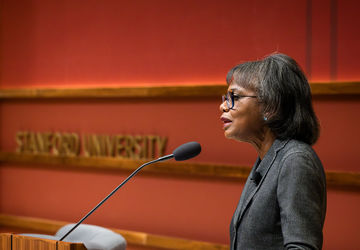Rethinking backlash: gendered bias within and across race

Academics are often unfairly accused of researching small, esoteric matters. This charge cannot be leveled at Brian Lowery. A professor of organizational behavior, and the Walter Kenneth Kilpatrick Professor in Stanford’s Graduate School of Business, Lowery grapples with some of the most urgent issues of our day, exploring the meaning of gender and its relationship to race. He shared his findings related to these complex interconnections at a recent Faculty Research Fellows talk at the Clayman Institute. Along with many other scholars and the public more broadly, Lowery sees gender as a social construct. However, while this idea is widely accepted, Lowery seeks to sharpen our understanding of the constructed nature of gender and its relationship to race.
Backlash is a key concept in Lowery’s work. He describes backlash as “the social and economic penalties people face when they are perceived to violate gender norms.” He is not the first researcher to examine this phenomenon. In fact, the literature is fairly clear on the fact that, perhaps surprisingly, white women pay a greater penalty than do women of color when violating gender norms. What is less clear is precisely why this might be, and scholars disagree about the causes. Some researchers point to racialized gender stereotypes as the explanation. Essentially, this theory suggests that race determines the content of gender stereotypes, and by extension, perceptions of violating specific gendered and racialized norms. Others emphasize the intersectional invisibility hypothesis, which posits that in the United States, the prototypical woman is imagined to be a white woman, and hence women of color are essentially not seen. Because of this imagined gender and racial configuration, most backlash focuses on white women.
While levels of gender bias are consistent across racial groups, Lowery’s research showed that respondents penalized women of their own racial group who challenged gendered norms to a greater degree than did people outside of that racial group.
Lowery proposes a third, intriguing possibility, arguing that “gender is conferred within, but not across, racial groups.” Since race shapes so much of American society, it operates as the key mechanism in this process. But this could change in different geographic and cultural contexts, Lowery adds. For instance, in India, caste might replace race as the container of social belonging. In order to test this idea of how gender is conferred, Lowery and his team conducted several studies.
While levels of gender bias are consistent across racial groups, Lowery’s research showed that respondents penalized women of their own racial group who challenged gendered norms to a greater degree than did people outside of that racial group. To take just two examples that Lowery shared, consider the cases of Christine Blasey Ford and Anita Hill. In 2018, Ford accused then-Supreme Court nominee Brett Kavanaugh of sexual assault. Analyzing data from both white and non-white respondents, Lowery found that white respondents judged her more harshly than did non-white respondents. Lowery found a similar pattern in the case of Anita Hill, who in 1991 accused then-Supreme Court nominee Clarence Thomas of sexual harassment. Black respondents judged Hill more harshly than did non-Black respondents. Each woman faced a higher penalty within her racial group, and a lower one across racial groups, when they challenged prevailing gender norms by leveling accusations at powerful men.
Lowery’s findings have far-reaching implications. He suggests that this work, in combination with evidence that racial threat increases expressions of sexism, hints that racism contributes to expectations that drive sexism. If true, the elimination of sexism might require the elimination of racism. While this connection between sexism and racism complicates responses to both, it offers important insights about how to create a more just, equitable world.


